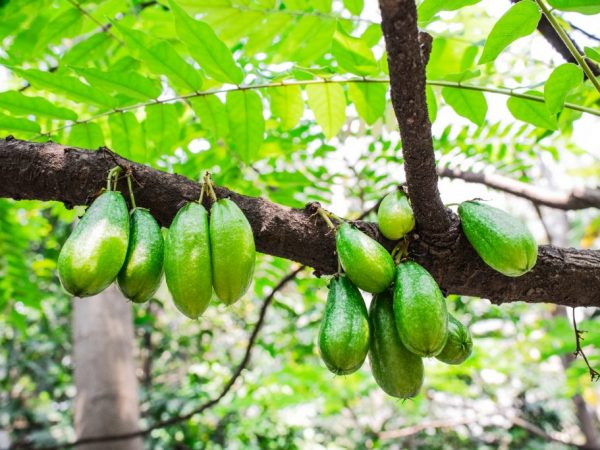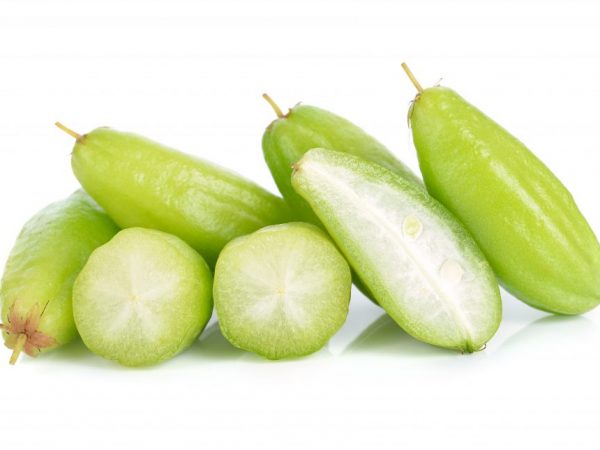Bilimbi cucumber tree
The cucumber tree is a rare, but easy-to-grow exotic crop. Its other name is the sorrel tree, or Averhoa bilimbi, the Acid family. A close relative of the plant is Averhoacarambola.

Bilimbi cucumber tree
Spread
The region of natural growth is the tropics and subtropics. The species is popular and widespread in India, Thailand, Singapore, Indonesia, Malaysia, and Zanzibar.
In 1793, Averhoa bilimbi was first introduced to Jamaica from Timor and the Moluccan Islands, which are considered its homeland, then within several years it was introduced to Central and South America under the name Mimbro. Commercial cultivation began in Queensland in the late 19th century. Today, there are cucumber plantations in Cuba, Puerto Rico, Venezuela, Trinidad, Colombia, Ecuador, Argentina, Nicaragua, Guyana, Suriname, Hawaii and South Florida.
Plant characteristic
Appearance and structure
It is a broadleaf deciduous tree. In the subtropics, the height of the cucumber tree usually does not exceed 10-15 m, in the tropics it reaches 35 m. In the greenhouse, the height of the plant is on average 4-5 m.
Small, fragrant, fragrant yellowish-green or purple flowers with dark purple markings are collected in small panicle inflorescences. Peduncles grow directly from the trunk. The flower consists of 5 petals.
Leaves are compound, 30-60 cm long, formed by 11-37 opposite leaves, 2-10 cm long each.
The fruits are ribbed, 5-8 cm in length, shaped like cucumbers, collected in a cluster, like a banana. The pulp is very sour, jelly-like, with small seeds, crunchy when unripe, bright green, turns yellow when ripe. The rind is glossy, very thin and delicate.
Inside each fruit there are 6-7 rounded flat brown seeds with a diameter of about 6 mm.
Growth features
Young seedlings are sensitive to cold and wind, the temperature for growing should be at least 30 ° C. Grown-up specimens become more resilient over time.
The cucumber tree grows well in rich, drained soils in areas with regular rainfall throughout the year, so it hardly occurs in areas with seasonal rainfall.
Reproduction occurs mainly by seeds, however, Vester successfully propagated seedlings with air layers 3.8-5 cm long.
The shelf life of the cucumber harvest does not exceed 5 days.
Cooking applications
The variety has found application in the cuisines of different countries:
- Costa Rica has a popular sauce made with fresh fruit as a seasoning for rice and beans, and sometimes for fish and meat.
- In India, ripe fruits are added to curries instead of mangoes in chutney, often mixed with sweet tamarind. In the regions of Kerala and Goa, fish sauce is made from the pulp with the addition of salt and spices.
- In Indonesia, Bilimbi is consumed dried; this dessert is called Asam sunthi.
- Sweet jam is traditionally made in Malaysia.
- In the Seychelles, they cook a sauce served with shark meat.

Lemonade is made from the fruit
Bilimbi contains a large amount of vitamin C, fresh juice is used to make lemonade. To reduce acidity, before cooking, the fruits are soaked in water overnight and then boiled with sugar. Depending on the proportion, jam or jelly is obtained.
Candied fruits are prepared from flowers with sugar. Half-ripe exotic cucumbers are salted and pickled. The finished product is stored for 3 months. Fast salting is carried out in boiling brine.
Application in traditional medicine
- Filipinos use a paste of Bilimbi leaves for itching, swelling, skin rashes, and rheumatism.
- Indians - from the bites of poisonous insects. The infusion of the leaves is drunk as a tonic. A decoction of flowers is effective for thrush and sore throat.
- Malaysians use the plant sap as eye drops.
Herbal preparations in the form of decoctions, infusions, powder or paste were previously used in traditional medicine for the prevention and treatment of scurvy, rectal inflammation, obesity and dermatoses.
Juice, containing a large amount of oxalic acid, whitens fabrics well, cleans rust stains.
The pulp contains a number of useful substances:
- oxalic acid,
- vitamin C,
- carbohydrates,
- proteins,
- amino acids,
- tannins,
- essential oils,
- flavonoids.
Found in the leaves:
- tannins,
- alkaloids,
- flavonoids,
- saponins,
- cardiac glycosides,
- carbohydrates,
- phenols.
Oxalic acid stimulates the work of muscles and the nervous system, has bactericidal properties. In large quantities, it can cause the development of urolithiasis.
Tannins are natural sorbents that remove carcinogenic substances from the body.
Essential oils restore water-salt balance, provide the body with useful minerals and vitamins.
Flavonoids affect the functioning of enzymes in the nervous and circulatory systems.
Saponins are used in the preparation of tonic, expectorant and sedative drugs.
Cardiac glycosides support normal heart function.
Phenols have a disinfectant effect on the respiratory tract and urinary system.
Alkaloids have a tonic and analgesic effect, have a positive effect on the nervous system.
The Nicaraguan Institute has scientifically proven the antimicrobial effective action of the leaf extract on the dangerous bacteria Bacillus cereus, Bacillus megaterium, Escherichia coli, Pseudomonas aeruginosa, Aspergillus ochraceous and Cryptococcus neoformans.
Conclusion
The Bilimbi cucumber tree is an exotic decorative leaf plant, a useful plant material for making delicious desserts and sauces.


